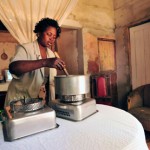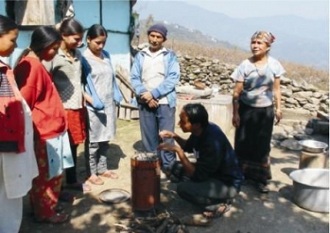Source: David Biello, Scientific American, May 31, 2012
Ethanol Scheme Bids to Clean Up Cooking
A new effort aims to build a for-profit, bio-based economy in Mozambique involving rotation farming, ethanol and clean cookstoves
A farmer in Mozambique grows peas, beans and cassava in rotation—enough to feed the family with a little to spare. The farmer then sells that excess to CleanStar Mozambique, which dries and packages the produce for sale in the capital, Maputo. But the company also takes the surplus cassava, a starch-filled root and local food staple, and sends it to an ethanol fermentation plant built by ICM, a U.S. ethanol company, that employs enzymes produced by Denmark-based Novozymes. The ethanol produced is then sold in reusable plastic bottles to people in Maputo who own one of the 3,000 or so ethanol-burning clean cookstoves sold by CleanStar. When the fuel runs out, more can be purchased at an incipient network of CleanStar shops.

CLEAN STOVE: This ethanol-burning stove will cut down on the soot from charcoal burning that otherwise blackens homes and lungs. Image: Courtesy of Novozymes
“We want to show that there is this idea of a bio-based society,” says chemical engineer Thomas Nagy, executive vice president for stakeholder relations at Novozymes, which helped start and fund the scheme. “This is not a philanthropic project.”
Novozymes and its corporate partners hope to create a bio-based, sustainable economy in Mozambique. Such an economy could point the way to reducing the two million annual deaths worldwide that result from breathing in smoky indoor air caused by burning charcoal. Currently, charcoal is the fuel of choice in much of the world and a nearly $10-billion market across sub-Saharan Africa. That is the market this ethanol-burning cookstove—and bio-based economy—aims to disrupt.
“Ethanol burns very clean,” Nagy notes. The CleanStar venture opened its first ethanol production plant on May 17 in Dondo, capable of brewing two million liters of fuel per year. “Charcoal might be cheaper but it has less energy content per kilo[gram].”
The problem in this case is: replacing cheap charcoal, which farmers make by cutting down and burning trees, requires dependence on a much more complex, new and unproved system. “People use charcoal because it is cheap and easy,” notes a prominent development expert who declined to be identified because of relationships with various clean cookstove donors and providers. “Ethanol is neither.”



